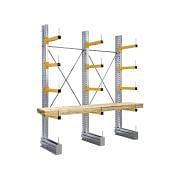Cantilever shelving
Cantilever racking is a type of storage system distinguished by its structure without front columns. These racks are supported by external arms that extend horizontally, allowing easy access to materials without obstacles. This feature makes them ideal for storing large and irregularly shaped objects, such as pipes, bars and other bulky materials.
The design of cantilever racks is extremely versatile. The arms can be adjusted in height and inclination, allowing complete customisation to suit different types of loads. This system allows easy organisation and access to materials, improving the operational efficiency of machine shops.
Advantages of Cantilever Racking in Mechanical Workshops:
1. Optimisation of Space
Cantilever racking is designed to maximise the use of space. Without the front columns, space is reduced and material management is optimised. This is particularly advantageous in machine shops where space is often limited and efficient material management is crucial.
2. Easy and immediate access
The open design of cantilever racking allows direct access to materials. This facilitates picking and storage operations, reducing search times and increasing productivity. In a machine shop environment, where downtime must be minimised, this feature is extremely useful.
3. Versatility and Adaptability
Cantilever racks can be easily adapted to meet different storage needs. Adjustable arms and modular components allow the system to be configured to suit specific needs, whether it is to store materials of varying lengths or to optimise space for heavy loads.
4. Robustness and Safety
Constructed from robust and durable materials, cantilever racks offer a solid base for heavy materials. Their robustness ensures that materials are stored safely, reducing the risk of accidents and damage. This is essential for maintaining a safe and orderly working environment.
5. Aesthetics and Organisation
In addition to functionality, cantilever racks improve the appearance of the machine shop. With a clean and uncluttered design, these structures contribute to a more organised and professional working environment, which can reflect positively on the corporate image.
Answers to Frequently Asked Questions
1. How do I choose the right cantilever racking for a machine shop?
The choice of cantilever racking depends on various factors, including the size of the materials to be stored, their weight and the space available. It is important to consider the load capacity of the arms, adjustability and robustness of the system to ensure that it meets the specific needs of the workshop.
2. What is the difference between cantilever racking and other types of racking?
Unlike traditional racking that has front columns, cantilever racking offers an open structure that facilitates access to materials. This design is particularly useful for storing large or irregularly shaped objects.
3. How is cantilever racking maintained and cleaned?
The maintenance of cantilever racking is relatively simple. It is important to periodically check the stability of the arms and the general condition of the structure. Cleaning can be done with standard tools to remove dust and debris, ensuring that the system remains in excellent condition.
Cantilever racks are a highly effective solution for space management and organisation in machine shops. Thanks to their open design, robustness and versatility, they offer numerous advantages, including greater optimisation of space, easier access to materials and improved safety.

